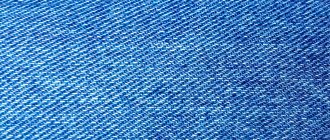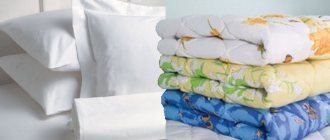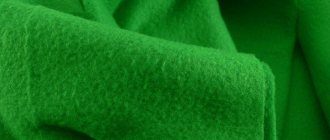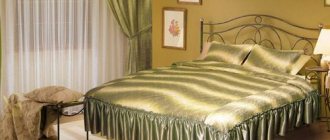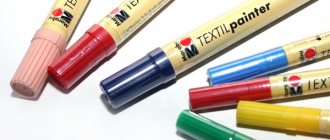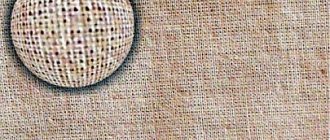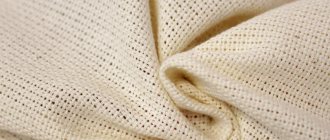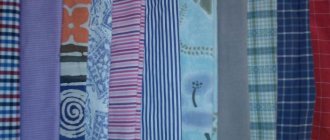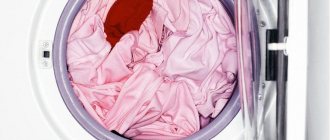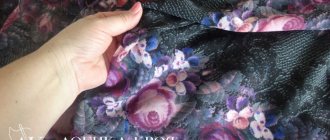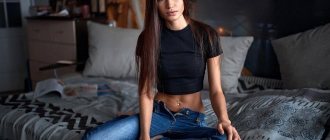Textile materials are created for a specific consumer niche. They are given the necessary qualities by combining fibers, special weaving and additional impregnation. Strength, wear resistance and protective characteristics, as well as comfort during use, should be in the first place in fabrics for sewing workwear. Thus, Greta matter appeared, meeting increased operational requirements.
What type of fabric is this
Greta is a mixed type of fabric, the inside side is natural, and the outside is synthetic. It is dense, but not heavy, holds its shape perfectly and hardly wrinkles. This material is produced in Belarusian factories and textile enterprises in China.
Greta colors
During the production process, the fibers are intertwined in such a way that the front part is synthetic and the back part is natural. Special impregnations are applied to the fabric to improve its protective properties. The canvases are painted in different shades, including those with printed patterns.
Composition and production
Gretta fabric consists of a mixed fabric, made in such a way that threads of polyester fibers are located on the outer surface, this gives additional wear resistance and also protects against dust. There is a cotton thread on the inside, which gives the product its shape and absorbs moisture well.
Gretta up close
Belongs to the category of those that keep their shape. Greta material does not shrink during washing and retains the original color and appearance for a long time. The material also undergoes a water-repellent treatment, which is good for use in rain or mud.
It has a twill weave of cotton and synthetic threads, which is the densest. The surface composition looks like a diagonal scar. There will be a sheen on the outside of the fabric.
Color palette
Greta fabric technical characteristics vary from 120–290 g/m2, and the most popular indicator is 170–220 g/m2. Available in a variety of colors, patterns or prints. The best color would be khaki, denim, khaki, black or navy blue.
Greta blend fabric is produced by combining two types of fibers in equal quantities. Gretta fabric composition consists of half natural materials, cotton (55%) and the other part (45%) synthetic polyester fibers. The latter gives strength and makes it easier to care for, while cotton makes it comfortable to wear and hygienic.
Greta allows air to pass through, allowing the body to breathe freely. Therefore, things made from this fabric are comfortable to wear at any time of the year. On the fabric market, Greta Premium or Greta medium density are sold more.
Gretta Premium
To provide protection from harmful weather conditions and unpleasant factors, they are specially treated with a water-repellent liquid. As a result of the treatment, air passes to the body, and external moisture is retained.
Note! For this property, this material is loved by fishermen and people involved in tourism.
Pros and cons of fabric
Greta advantages:
- does not tear or wear out;
- the color does not fade even with intensive use;
- air circulation occurs due to the natural fibers in the composition;
- perfectly protects from wind and moisture;
- light weight, even with high density, makes clothing comfortable;
- not demanding in care;
- wide color variety;
- does not wrinkle even with prolonged wear;
- its cost is relatively low;
- The service life is quite long.
Along with the advantages, Greta also has several disadvantages:
- difficulties during cutting;
- the rough structure of the material makes it impossible to sew everyday clothes from it;
- Not sold in all stores.
Technical and physical descriptions
Any dye applies easily to it and lasts a long time, so the fabric can be of different colors to suit every taste. Does not shrink, does not fade after washing, and also holds up well in the sun.
You might be interested in this. Detailed description of capitonium: what is such fabric
Greta combines the advantages of cotton and polyester well. The main technical parameters include:
- Tenderness and ease of use;
- Beautiful appearance with some shine;
- Not heavy, the body breathes;
- Hygienic and hygroscopic;
- Does not get wet;
- Keeps its appearance and does not stretch;
- Resistant and durable;
- Withstands constant use;
- Does not require special care and does not wrinkle;
- Does not shrink when washed and does not fade;
- Hypoallergenic.
An example of strength (leather zam on the left, gretta on the right)
There are also special qualities due to impregnation:
- Does not allow moisture to pass through;
- Repels dirt;
- Wind protection;
- Prevents oil particles from getting on the body;
- Doesn't ignite from a spark.
Camouflage
Greta fabric - consists of a mixture of cotton and polyester, which has become very beneficial in terms of application and its benefits, appreciated by customers. Things made from this fabric can be worn for a long time, and they will also look new.
When washed, things do not change in size or appearance. The cotton inner side of the material is comfortable to the body and does not cause sweating. The synthetic upper gives the material a beautiful, subtle sheen. Dirty items made from this fabric can be easily washed. And dust can be removed even with a dry brush.
What standards are used in production? What do they take into account?
The greta material complies with the standards of GOST 29222-91 “Cloak fabrics made of chemical fibers and mixed”. It determines the standards for fabrics made from a mixture of synthetics and cotton used for sewing raincoats, jackets and sportswear. According to GOST, fabrics must meet standards for physical and mechanical parameters, such as breaking load, pillability, water resistance, frayability, and crease resistance.
In addition, GOST specifies standards for the color fastness of fabrics and their density.
Sports and tourism
The fabric is used to create clothing for fishermen and men who lead an active lifestyle: fishermen, hunters, wildlife lovers. It is well used in sewing sports equipment and clothing for outdoor activities.
Gretta tent
Tents, backpacks, cases for weapons, knives, and fishing chairs are made from it. Used to create shoes, gloves and baseball caps. Pants and tops are worn in everyday life at dacha work. Also used for furniture upholstery. It does not collect dust, is easy to clean and does not allow moisture to pass through. Car covers are made from it.
You might be interested in this Features of fuqra: fabric properties
Types and their properties
In the characteristics of Greta fabric, we noted that the ratio of artificial and natural fibers (composition) varies. In addition, designs and applications also vary, which allows us to talk about the types of material.
- Greta fabric marked M is used to make clothes for hazardous production. The electrically conductive threads included in the composition do not accumulate electricity, therefore, the material is not dangerous if a spark accidentally hits it.
- Camouflage fabric (KMF) - clothes are sewn from it for the military, as well as for peaceful purposes for fishing or hunting. This fabric is often called “Greta multicam”.
- Greta fabric with article number 4s5kv is available in solid colors (black, blue, red) and is most often used for sewing workwear for builders, security guards, and people of similar professions. Products made from it, as well as from Greta 4c5, are in demand among farmers and road workers.
- Light is a lighter fabric with the same properties from which summer overalls are sewn.
According to GOST, greta fabric can have different compositions and different impregnations. When choosing, you should pay attention to the percentages indicated in specific numbers. For example, the marking 51 49 indicates that this type of fabric is 51% cotton and 49% synthetic.
Characteristics that make the material popular
Thanks to twill weaving, the use of natural and synthetic fibers, and various types of impregnations, Greta is a universal fabric.
Its advantages:
- Hygiene: Greta is a “breathable” fabric that allows air to pass through and ensures proper perspiration.
- Hygroscopicity: the cotton backing absorbs sweat well.
- Comfortable: the inner side is made of natural cotton and is pleasant to the body and does not cause discomfort.
- Wear resistance: due to the increased density, the material is resistant to abrasion, cuts, and breaks.
- Health safety: does not cause allergic reactions.
- Resistant to dirt and moisture.
- Light weight: even the most voluminous clothes do not weigh down when worn.
- Dimensional stability, low degree of shrinkage.
- Permanent coloring: the material does not fade.
- Rich color palette.
- No rustling noise when moving.
As for the shortcomings, the Greta has almost none. The disadvantage is the rough structure, so the fabric is not suitable for sewing ordinary clothes.
Fact! Practicality combined with low cost made Greta fabric not only the most popular in its class, but also often counterfeited.
Greta is a Belarusian trademark
In this fabric, the threads are intertwined in such a way that one side of the fabric (in products this is the wrong side) is cotton, the other is made of polyester. To give the fabric additional qualities, the top layer can be treated with special compounds.
It can be of different densities (from 110 to 280 g per square meter), the standard is 190 - 220 g/m2, denser fabric is rarely used.
It can be plain-dyed or with a printed pattern, most often it is camouflage and is labeled as KMF. Can also have a Jeans pattern.
The owner of the “Greta” trademark is the largest textile enterprise in the Republic of Belarus, OJSC “Mogotex” (Mogilev Textiles), and without its permission it is impossible to call homogeneous goods (fabrics) by this name.
Where is the material used?
Fabric with excellent strength and protective properties, which sews well and does not require maintenance, is used in various fields.
The main purpose for greta is work and protective clothing, overalls, and uniforms for employees of security organizations. Hunters and fishermen loved equipment made from this fabric. The material is used for military and rescue uniforms.
Greta is used to make jackets, trousers, hats, overalls and jackets. The water- and dirt-repellent form is used by builders and utility workers, workers in heavy and explosive industries, energy and oil workers, kitchen and hairdressing workers. Greta fabric is suitable for summer and winter workwear.
Farmers and road workers enjoy wearing Greta clothing because it is not afraid of rain and dirt. A jacket made of this material will protect you while working in the garden and on a hiking trip.
Tents, backpacks, covers, folding chairs, awnings and awnings are made from durable and waterproof material. The fabric is also suitable for upholstering furniture and sewing protective covers.
Where can I purchase the material?
You can buy Greta in a department of a store with a wide range of fabrics, or in retail outlets that sell special fabrics and textiles for workwear. Greta is in demand among buyers because she is good-quality, comfortable and looks good. It meets quality and safety requirements.
Online stores also offer to buy Greta, and do it without leaving your home. All you need to do is contact the managers or fill out an application online. All colors available.
The price of the material is determined by the density, percentage of cotton and polyester in the composition and the manufacturer. The standard width of the canvas is 1.5 m. The cost of 1 linear meter ranges from 65-150 rubles.
The stores have direct supplies from domestic manufacturers and from China in order to offer their customers the best quality and price. The material you like can be purchased in small wholesale - at least 1 roll, medium and large wholesale at competitive prices. There is a retail table starting from a few meters.
Application for workwear
This fabric is used for sewing workwear and uniforms for various specialties.
Winter fishing suit
Note! It is used to make things for various law enforcement agencies, security organizations, police officers, and rescuers. Its excellent protective properties and ability to keep a good appearance make it suitable for wearing in different weather conditions.
Greta workwear fabric is also happily used in the food industry, canteens, shops, beauty salons and other service sectors. It is chosen due to its hypoallergenicity, ability to conduct air well, internal absorbent surface and excellent hygienic qualities.
Greta with special finishes is used in oil and gas, energy plants, and the nuclear industry. Items with finishing have antistatic characteristics, protecting a person from the collection of static current and the possibility of fire from a spark. It can repel particles of various petroleum products and oils and is needed in hot shops due to its excellent protection against sweating.
Also equipped with acid-proof characteristics. Its properties are used in the field of national economy. In the villages they happily wear such things. They do not need constant washing and protect a person from rain, snow, wind and dirt.
Note! They also make things for utility workers, construction workers, asphalt workers, and also create vests for various services.
Varieties, performance characteristics
Greta varies in structure density, coloring properties, and finishing methods. The density of the fabric can be very different: from 110 to 280 g per 1 square meter of fabric . According to the dyeing method, it can be plain-dyed or printed (KMF, denim). Camouflage fabric comes in a variety of colors and patterns. Plain dyed is distinguished by the brightness of its colors.
The finishing gives the fabric special properties . It consists of various impregnations and coatings. Thanks to this, the canvas becomes multifunctional. It acquires:
- water-repellent;
- oil-repellent;
- oil-repellent;
- dirt-repellent;
- windproof properties.
There is a type of fabric with electrically conductive threads, Greta-M . This has anti-electrostatic properties. Very dense, VO-impregnated fabric - Greta-P Premium . Greta-P - less dense. These species are more common than others in consumer markets.
The fabric does not wrinkle, does not fade in the sun, does not lose color and shape after washing , and does not shrink. Very comfortable to use, it is easy to wash thanks to the synthetic outer surface.
At the same time , dirt that gets on the products can be easily cleaned without the use of special cleaning agents directly during wear. Dust does not penetrate deep inside due to its high density. This same characteristic allows it to be wear-resistant and used for a long time.
The cotton back side of the products allows them to absorb moisture. This is very convenient when wearing in high temperature conditions. Water resistance allows you to wear clothes in rain and snow without fear of getting wet.
Reviews of Greta fabric
There are many reviews on the Internet about mixed fabric.
Nikolay: “The suit has advantages and disadvantages. The advantages include repelling dirt and moisture. The disadvantages are a slight rustling when walking. This is unacceptable during hunting.”
Alexey: “A suit made of this material dries quickly and does not get dirty. There are convenient pockets on the clothes. I didn't find any shortcomings. I wore a Greta suit for a 2-week hike in the forest.”
Natalya: “The Greta suit is high quality and comfortable. It's a shame, it's not always possible to choose a size for women. The range of sizes is small. Practicality did not disappoint.”
Alexander: “Every detail in the suit was thought out. The quality of tailoring is good, it looks great, especially in a dense forest.”
What to sew from Greta
This fabric is very functional and durable. Simplicity in coloring allows you to create any design of a thing. You can make logos, embroider, and prints on Greta fabric. The protective characteristic increases the strength of the fabric and makes it useful when used in extreme weather conditions.
Gretta beach bag
Greta fabric is used for sewing such things as:
- For sports and active recreation;
- For fishermen and hunters;
- Winter jackets;
- Uniform for the military;
- Signal clothing;
- Uniforms for factory workers;
- Uniforms for hospital workers and recreational staff;
- Regular clothes (pants, sweaters, suits, robes);
- Car covers;
- Bags and umbrellas.
Note! A wide range of uses suggests that this fabric is universal. The low price makes items made from this fabric affordable for every family, increasing the popularity of outdoor activities and dress codes in organizations.
Applications and selection of appropriate material
The scope of use of Greta fabric is predetermined by its unique technical characteristics.
Author:
Zakharova Nina Afanasyevna
I hope you like my article! If you find any shortcomings, just write to me about it! I am always ready for a conversation and will answer any questions you have, ask them!
